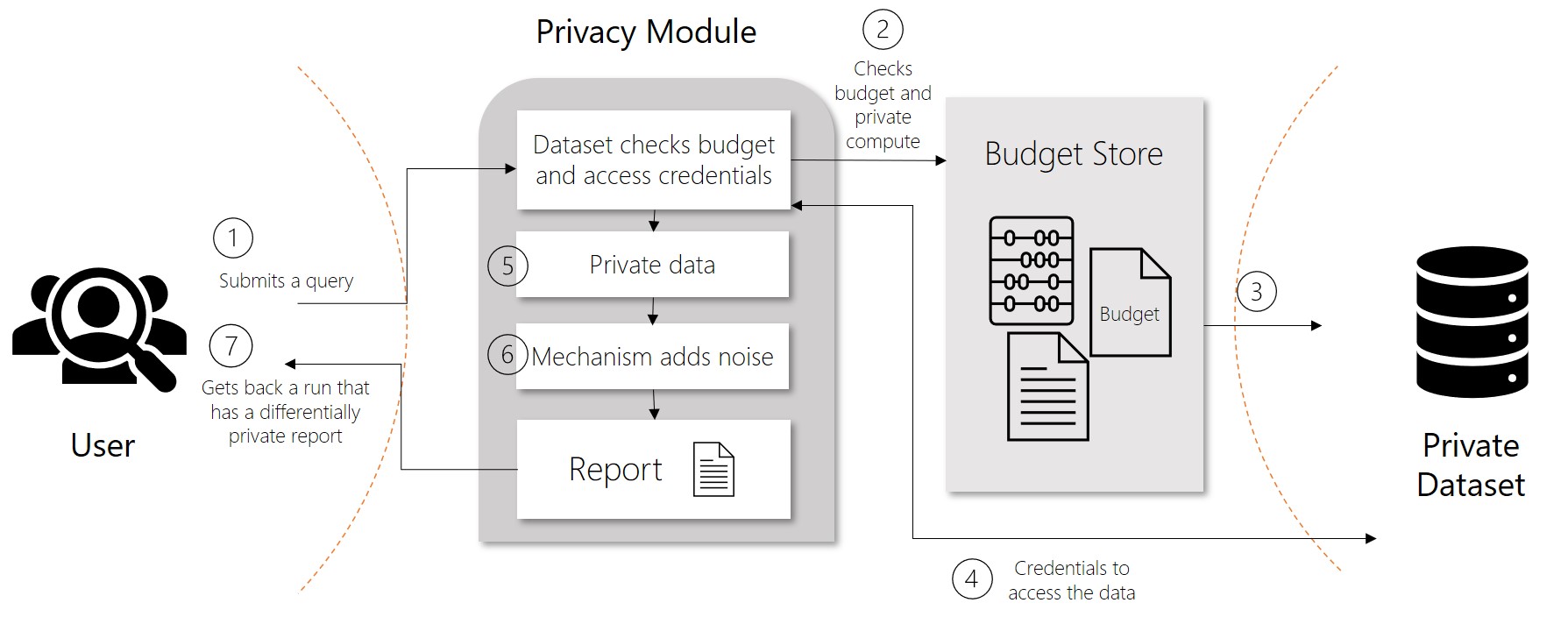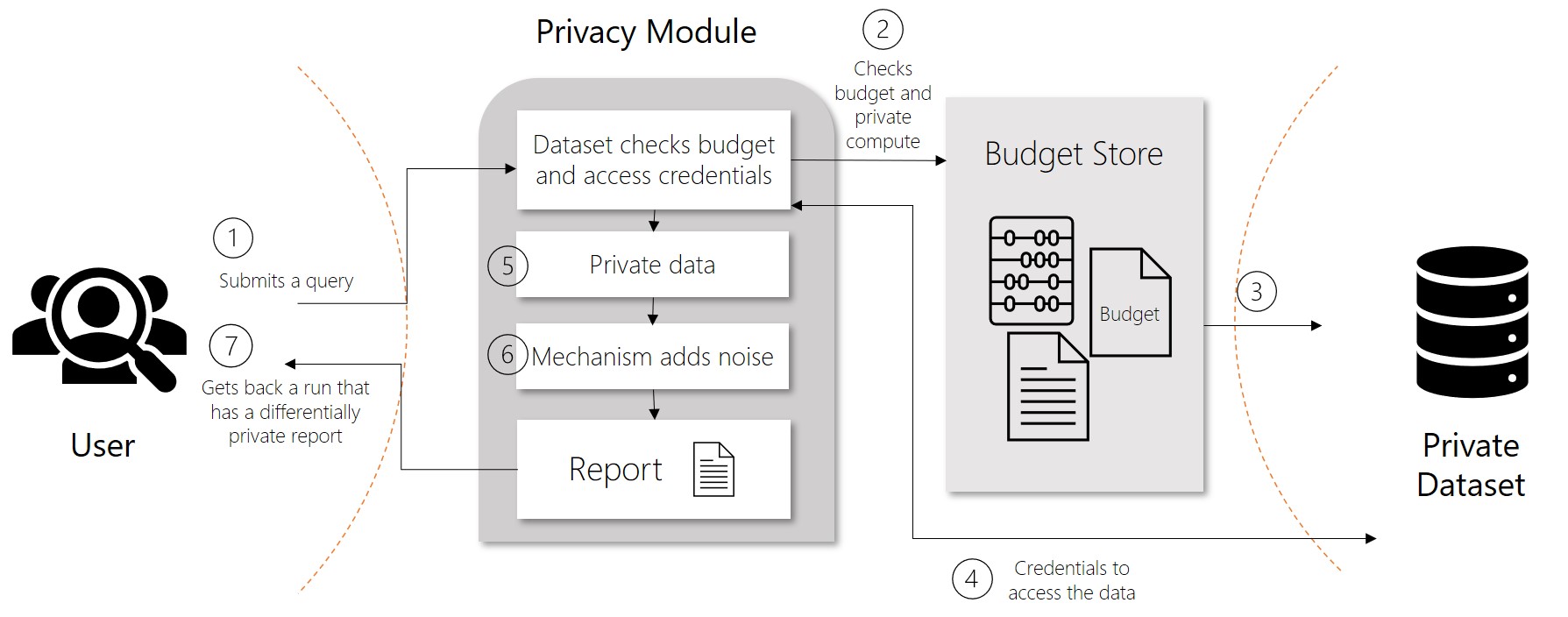
How differential privacy works
Differential privacy is a set of systems and practices that help keep the data of individuals safe and private. In machine learning solutions, differential privacy may be required for regulatory compliance.
In traditional scenarios, raw data is stored in files and databases. When users analyze data, they typically use the raw data. This is a concern because it might infringe on an individual’s privacy. Differential privacy tries to deal with this problem by adding “noise” or randomness to the data so that users can’t identify any individual data points. At the least, such a system provides plausible deniability. Therefore, the privacy of individuals is preserved with limited impact on the accuracy of the data.
In differentially private systems, data is shared through requests called queries. When a user submits a query for data, operations known as privacy mechanisms add noise to the requested data. Privacy mechanisms return an approximation of the data instead of the raw data. This privacy-preserving result appears in a report. Reports consist of two parts, the actual data computed and a description of how the data was created.
Differential privacy metrics
Differential privacy tries to protect against the possibility that a user can produce an indefinite number of reports to eventually reveal sensitive data. A value known as epsilon measures how noisy, or private, a report is. Epsilon has an inverse relationship to noise or privacy. The lower the epsilon, the more noisy (and private) the data is.
Epsilon values are non-negative. Values below 1 provide full plausible deniability. Anything above 1 comes with a higher risk of exposure of the actual data. As you implement machine learning solutions with differential privacy, you want to data with epsilon values between 0 and 1.
Another value directly correlated to epsilon is delta. Delta is a measure of the probability that a report isn’t fully private. The higher the delta, the higher the epsilon. Because these values are correlated, epsilon is used more often.
Limit queries with a privacy budget
To ensure privacy in systems where multiple queries are allowed, differential privacy defines a rate limit. This limit is known as a privacy budget. Privacy budgets prevent data from being recreated through multiple queries. Privacy budgets are allocated an epsilon amount, typically between 1 and 3 to limit the risk of reidentification. As reports are generated, privacy budgets keep track of the epsilon value of individual reports as well as the aggregate for all reports. After a privacy budget is spent or depleted, users can no longer access data.
Reliability of data
Although the preservation of privacy should be the goal, there’s a tradeoff when it comes to usability and reliability of the data. In data analytics, accuracy can be thought of as a measure of uncertainty introduced by sampling errors. This uncertainty tends to fall within certain bounds. Accuracy from a differential privacy perspective instead measures the reliability of the data, which is affected by the uncertainty introduced by the privacy mechanisms. In short, a higher level of noise or privacy translates to data that has a lower epsilon, accuracy, and reliability.
Open-source differential privacy libraries
SmartNoise is an open-source project that contains components for building machine learning solutions with differential privacy. SmartNoise is made up of the following top-level components:
- SmartNoise Core library
- SmartNoise SDK library
SmartNoise Core
The core library includes the following privacy mechanisms for implementing a differentially private system:
| Component | Description |
|---|---|
| Analysis | A graph description of arbitrary computations. |
| Validator | A Rust library that contains a set of tools for checking and deriving the necessary conditions for an analysis to be differentially private. |
| Runtime | The medium to execute the analysis. The reference runtime is written in Rust but runtimes can be written using any computation framework such as SQL and Spark depending on your data needs. |
| Bindings | Language bindings and helper libraries to build analyses. Currently SmartNoise provides Python bindings. |
SmartNoise SDK
The system library provides the following tools and services for working with tabular and relational data:
| Component | Description |
|---|---|
| Data Access |
Library that intercepts and processes SQL queries and produces reports. This library is implemented in Python and supports the following ODBC and DBAPI data sources:
|
| Service | Execution service that provides a REST endpoint to serve requests or queries against shared data sources. The service is designed to allow composition of differential privacy modules that operate on requests containing different delta and epsilon values, also known as heterogeneous requests. This reference implementation accounts for additional impact from queries on correlated data. |
| Evaluator |
Stochastic evaluator that checks for privacy violations, accuracy, and bias. The evaluator supports the following tests:
|
Next steps
Learn more about differential privacy in machine learning:
-
How to build a differentially private system in Azure Machine Learning.
- To learn more about the components of SmartNoise, check out the GitHub repositories for SmartNoise Core, SmartNoise SDK, and SmartNoise samples.

